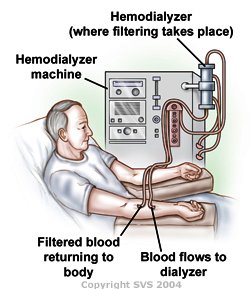Nanotechnology Developing Implantable Nano-Kidneys to Replace Dialysis
 Dialysis is a poor substitute for working kidneys. But there is a perpetual shortage of donor kidneys for transplant. Technology Review looks at nanotechnology research that hopes to provide a better alternative to dialysis--an implantable nanotech kidney.
Dialysis is a poor substitute for working kidneys. But there is a perpetual shortage of donor kidneys for transplant. Technology Review looks at nanotechnology research that hopes to provide a better alternative to dialysis--an implantable nanotech kidney.The common regimen of three half-day blood-cleansing sessions per week removes, on average, just 17 percent of the toxins that a healthy kidney would clear, so that only one-third of all dialysis patients survive more than five years of treatment.Source.
Nanotechnology could offer an alternative, according to nephrologist William Fissell at the University of Michigan. He and colleagues are working on nano-pore membranes that could enable dialysis to be miniaturized into implantable devices that provide round-the-clock clearance of toxins, untethering dialysis patients from bulky pumps and clinics. "This is a fundamentally liberating technology," says Fissell.
....As currently practiced, dialysis is a crude procedure. Patients are hooked up intravenously to a powerful pump that circulates their blood through a cartridge of porous plastic fibers. Fluids, dissolved toxins, and salts pass through the fibers and are discarded, while the proteins and blood cells caught in the sieve are supplemented with electrolyte before returning to the patient. The filter's poor fluid dynamics are a function of their imprecision: filter manufacturing produces a wide range of pores, so to avoid having too many large pores, which would suck out valuable proteins, the fibers must be manufactured with a preponderance of very small pores. The machine's pump makes up the difference, forcing blood through these inefficient sieves.
In contrast, Fissell and Roy etch pores into ultrathin wafers of silicon with lithographic precision. The result is a homogenous array of pores, each capable of flow rates several orders of magnitude higher than the average pore in a conventional filter. The pores mimic the exquisitely precise yet efficient diaphragms that filter blood in a human kidney, resembling a panel of Venetian blinds, says Fissell.
Current prototypes contain roughly 10,000 pores per square millimeter, according to Fissell. Next-generation membranes, now being engineered, will have more than 100,000 pores or slits per square millimeter and provide more than 10 times the flow.
....Fissell's team is testing whether the kidney sorts not only by size but also by generating electrical charges that repel protein chains, which are also charged. They're modeling various chemical modifications to introduce charges on the surface of the silicon pores.
To make the system practical will require rendering the membranes biocompatible. Unmodified silicon strongly attracts proteins, and thus a silicon nano-pore membrane would rapidly clog if implanted in the body. Fissell's colleague at the University of Michigan, David Humes, has initiated animal studies with the nano membranes to identify surface treatments or alternative membrane materials that will prevent clogging in implants.
Humes hopes to use the membranes to fashion a more sophisticated version of the implant that would contain living kidney cells--analogous to his "bioartificial" Renal Assist Device that's currently in phase two clinical trials (see "Saving Lives with Living Machines," July/August 2003). In an implantable version of the bio-artificial kidney, nano-pore membranes would protect the live kidney cells from immune cells and antibodies, which have thwarted most bio-artificial organ implants to date. The live kidney cells, in turn, would improve the function of the implant by reabsorbing and returning to the bloodstream some of the fluids and salts that pass through the nano-pore membrane. Eventually, bio-artificial implants that recover fluids and salts and divert the remaining ultrafiltrate to the bladder might even eliminate the need for external electrolyte and ultrafiltrate bags.
Replacement organs that work well, and allow mobility, would improve the lives of hundreds of thousands of people. Whether from nanotechnology, stem cell research, or other advanced technology, most people in need of replacement organs would probably not quibble.
Labels: artificial organs, bionanotechnology, Nanotechnology

0 Comments:
Post a Comment
“During times of universal deceit, telling the truth becomes a revolutionary act” _George Orwell
<< Home